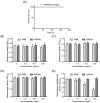AWRK6, A Synthetic Cationic Peptide Derived from Antimicrobial Peptide Dybowskin-2CDYa, Inhibits Lipopolysaccharide-Induced Inflammatory Response
- PMID: 29463000
- PMCID: PMC5855822
- DOI: 10.3390/ijms19020600
AWRK6, A Synthetic Cationic Peptide Derived from Antimicrobial Peptide Dybowskin-2CDYa, Inhibits Lipopolysaccharide-Induced Inflammatory Response
Abstract
Lipopolysaccharides (LPS) are major outer membrane components of Gram-negative bacteria and produce strong inflammatory responses in animals. Most antibiotics have shown little clinical anti-endotoxin activity while some antimicrobial peptides have proved to be effective in blocking LPS. Here, the anti-LPS activity of the synthetic peptide AWRK6, which is derived from antimicrobial peptide dybowskin-2CDYa, has been investigated in vitro and in vivo. The positively charged α-helical AWRK6 was found to be effective in blocking the binding of LBP (LPS binding protein) with LPS in vitro using ELISA. In a murine endotoxemia model, AWRK6 offered satisfactory protection efficiency against endotoxemia death, and the serum levels of LPS, IL-1β, IL-6, and TNF-α were found to be attenuated using ELISA. Further, histopathological analysis suggested that AWRK6 could improve the healing of liver and lung injury in endotoxemia mice. The results of real-time PCR and Western blotting showed that AWRK6 significantly reversed LPS-induced TLR4 overexpression and IκB depression, as well as the enhanced IκB phosphorylation. Additionally, AWRK6 did not produce any significant toxicity in vivo and in vitro. In summary, AWRK6 showed efficacious protection from LPS challenges in vivo and in vitro, by blocking LPS binding to LBP, without obvious toxicity, providing a promising strategy against LPS-induced inflammatory responses.
Keywords: AWRK6; antimicrobial peptide; inflammatory response; lipopolysaccharides (LPS).
Conflict of interest statement
The authors declare no conflict of interest.
Figures






References
-
- Rhodes A., Evans L.E., Alhazzani W., Levy M.M., Antonelli M., Ferrer R., Kumar A., Sevransky J.E., Sprung C.L., Nunnally M.E., et al. Surviving sepsis campaign: International guidelines for management of sepsis and septic shock: 2016. Intensive Care Med. 2017;43:304–377. doi: 10.1007/s00134-017-4683-6. - DOI - PubMed
MeSH terms
Substances
LinkOut - more resources
Full Text Sources
Other Literature Sources
Miscellaneous

